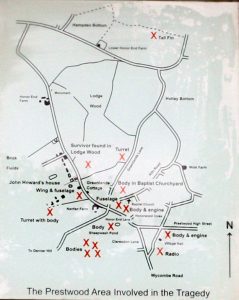.
G
H
J
M
P
R
S
T
W
Basil Frederick Percy Bamsey Wingfield
This concludes those names on Launceston’s War memorial below are the men from or had a connection to ‘Lanson’ that are not on the memorial.
Bernard Victor Hiram Bulmer
Air Craftman 1st class (Service No. RAF 569834) : He was killed whilst flying in Sunderland I, L5799 KG-D of No 204 Sqn, which was shot down in combat with a He 111 on April 8th, 1940. The plane crashed into the sea west of Bergen, Norway, during a reconnaissance mission. His Father was born in Liverpool and married Mabel. Bernard was born in 1920 at Totnes, Devon before the family moved to take over the Northgate Inn, Launceston, Bernard attended Launceston College. He joined the RAF straight from school serving a three year apprenticing as a wireless electrical mechanic. He was a keen sportsman winning the RAF heavy weight apprentices championship plus whilst in Launceston winning many swimming trophies. His body was never recovered but he is commemorated on the Runnymede Memorial, Panel 24, and on the Launceston War Memorial.
Kenneth William Cock
Kenneth was born in 1919 to Frederick William and Annie Cock at Launceston. He enlisted with the Royal Navy (Service No. D/KX 91135) as a Stoker First Class. H e was serving aboard ‘HMS Ardent’ when it was sunk on the 9th of June 1940. His body was never recovered but his name is commemorated on the the Plymouth Naval Memorial Panel 41 column 1. He is also commemorated on the Launceston War Memorial and St Stephens Roll of Honour.
HMS Ardent was detached from Ark Royal on the 8th of June, and joined Acasta in escorting Glorious back to Scapa Flow. En route, the three ships were discovered by the German warships Scharnhorst and Gneisenau. Ardent and Acasta laid a protective smokescreen to hide the British ships, and engaged the German ships with her 4.7 in (120 mm) main armament, which proved to be ineffective at the range of the targets. Despite coming under heavy fire from the much larger guns of the Germans, Ardent carried out a torpedo attack. She managed to score a single hit with her 4.7 in (120 mm) gun, but was struck repeatedly by enemy shells. Ardent eventually capsized with the loss of 10 officers and 142 ratings. Acasta and Glorious were also sunk in the engagement.
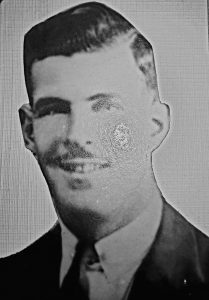
Lionel was born in 1915 to Lionel and Cicily (nee Jones) Decieco at Launceston. (His Father was born in Sant’Elia, Caserta, Italy in 1892 and moved to Penzance before 1914, serving during WW1 in the Reserve Heavy Battery (Regimental No 1905), Territorial Force Rank Gunner. He Got 14 Days Restricted Privileges on 9/7/1918 For Stealing Potatoes. He was Discharged On 13/3/1919. His Number was changed when he moved over to Royal Garrison Artillery.) Lionel senior worked as a carpenter and the family lived at 32 Northgate Street.
Lionel junior was a gunner with the Royal Artillery (Regimental no 826423). He was killed on the 1st of June 1940 at Dunkirk and is buried at Marquise Communal Cemetery, Marquise, Departement du Pas-de-Calais, Nord-Pas-de-Calais, France, Plot: Plot 1. Row A. Grave 13.
Lionel had married and his widow was Phyllis Mary Decieco, of Crowborough, Sussex and they had one son.
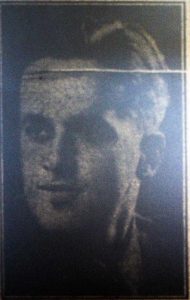
Francis was born in September 1916 to Mr And Mrs G. Duke at Tower Street, Launceston. He went to work for Mr Stanley Parsons as a Baker and Roundsman and was very well known because of this. He was also a member of Launceston’s Brotherhood. He married Winnifred Ellacott of Hatherleigh in 1938 at Launceston and they set up home at 2 Station Road, Launceston. He enlisted with the Argyll and Sutherland Highlanders (Princess Louise’s) (Regimental No. 5440993) in March 1940 seeing considerable service (thought to be with the 9th Battalion) in Ireland before his posting on the continent. The 9th Battalion, a Territorial unit, was converted to artillery as the 54th Light Anti-Aircraft Regiment, Royal Artillery comprising three batteries from the former Companies: 160 (Dumbarton), 161 (Alexandria) and 162 (Helensburgh) Former B Company (Kirkintilloch) and D Company (Clydebank) formed the nucleus of the second-line regiment, the 58th LAA, comprising 172,173 and 174 Batteries. From May 1941 they served as part of the 11th Armoured Division initially as part of 11th Support Group until it was disbanded 1 June 1942, then transferring to Divisional Troops. In 1944 they were deployed in Operation Overlord and later that year south and east of Eindhoven, Holland. It was here on the 24th of January 1945 that Francis was killed in action He is Buried at the Venray War Cemetery, Venray, Venray Municipality, Limburg, Netherlands, Plot: III. F. 3.
Geoffrey William Geake
Geoffrey was born in 1913 to Mr and Mrs Lawrence Geake (His Mothers maiden name was Lintern) at Tavistock. By 1942 the family had moved to Duke Street, St. Stephens, Launceston. He enlisted with the Royal Navy serving as an Able Seaman (Service No. D/JX185481). He was serving aboard ‘HMS Jupiter’ when she was sunk off the north Java coast in the Java Sea on 27 February 1942, at 2116 hours, by a mine laid earlier in the day by the Dutch minelayer Gouden Leeuw. Initially, the explosion was thought to be caused by a Japanese torpedo. Geoffrey was killed in the explosion. His body was never recovered but his name is commemorated on the Plymouth Naval Memorial Panel 65 column 1. He is also commemorated on the Launceston War Memorial and St Stephens Roll of Honour.
Frank Albert Henry Gillard
Frank was born in 1924 to Frank Hawkins and Alice Maud Brown (nee Bennett) Gillard at Launceston. His Father is listed as being the Master of public assistance institution.
He enlisted with the Royal Navy as a Sick Berth Attendant (Service No. D/MX 111010). He was serving aboard ‘HMS Loch Gorm’ when he died on the 22nd of December 1945.
At the time of his death the family were living at Pages Cross House, Launceston. He is buried at Launceston Cemetery, plot G. G. Grave 161.
Noel John Goodman
Noel was born in 1925 to Mr and Mrs S. Goodman at Trelawney Terrace, Launceston. His Mothers maiden name was Skitmore. Before the war he had been working for Treleavens outfitters, Southgate Street. He married Ethel Beckett of Knottingly, Yorkshire in 1942 and they had two Daughters, Pat and Sandra and living at 42 Tower Street, Launceston. He enlisted with the Royal Marines (Service No. PLY/X 108680) and died on the 1st of November 1944 aboard a Gunboat LCS(L).252, which was taking part in operation Infatuate the ‘Walcheren Landings’ and was lost in battle off the coast of Belgium.
Operation Infatuate was the codename given to an Anglo-Canadian operation during the Second World War to open the port of Antwerp to shipping and relieve logistical constraints. The operation was part of the wider Battle of the Scheldt and involved two assault landings from the sea by the 4th Special Service Brigade and the 52nd (Lowland) Division. At the same time the 2nd Canadian Infantry Division would force a crossing of the Walcheren causeway.
His body was never recovered.
Thomas Charles Hawkins
Thomas was born in 1913 at East Stonehouse, Plymouth. (His Mothers maiden name was Huggins). He was a talented musician being able to play both the Violin and piano proficiently and was always in demand for concerts. He was also a member of the Brotherhood.
He enlisted with the Royal Marines in 1933 (Service No. PLY/X 1028). He was a gunlayer (the person who controls the angle of elevation of a gun), serving aboard ‘HMS Neptune’.
On the night of 19 December 1941 the Cruiser ‘HMS Neptune’ ran into an uncharted minefield in the Mediterranean off Tripoli, and sank with the loss of 764 officers and men. Just one man was rescued by an Italian torpedo boat, after 5 days in the water.
Thomas was reported as missing on January 1942 presumed dead. His body was never recovered but his name is commemorated on the Plymouth Naval memorial, Panel 59 Column 3. At the time of his death his mother was living at Hendra, Dunheved Road, Launceston. In his will he left £150 12s. 3d. to Ellen Bray (Wife of Stanley Bray).
Ernest Roy Harris
Ernest was born on June 17th, 1914 at 12 Northumberland Place, Teignmouth the only son of Albert Edward and Emma (nee Undery) Harris. His father was a grocer’s assistant, but who had served with the Army Veterinary Corps (Regimental No. SE26857) serving with the 18th Battalion in Salonika from 1917 until his de-mob in 1920. In the 1939 register he is shown as being a radio engineer. He enlisted as a Sergeant Wireless operator/Gunner with the R.A.F. Volunteer Reserve (Service No: 1310418) serving with 521 Sqdn. He was killed on October 4th, 1942, whilst flying in a Lockheed Hudson IIIA, FH379 of No 521 Sqn, his aircraft was on a RHOMBUS sortie (Hudson FH 379) from Bircham Newton, Norfolk, and had been delayed by thick fog, but the aircraft captain eventually decided to attempt a take-off at 0715 hours. In fact thick fog still blanketed the airfield, and the aircraft appears to have started swinging to port during the take-off run. Sufficient altitude was gained to clear a hangar – but not a radio-mast. The collision sliced off the starboard wing and, as the aircraft crashed at 0718 hours, the tanks exploded engulfing the wreckage in flames.
He was interred at the Kensal Green Cemetery, London, Plot B. Grave 12. He was the husband to Phyllis May Harris, of Dawlish. They had one daughter. At the time of his death, his parents were living in Launceston. His name is commemorated upon the Dawlish and Launceston War Memorials.
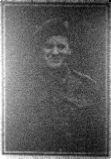
William or Bill as he was known was born on the 27th of June 1914. His Mothers maiden name was Ball. He was working on the railway as a Lengthman when he enlisted with the Duke of Cornwalls Light Infantry (Regimental No 5442008) as a Private. He was killed in action whilst attending the wounded at Normandy on the 27th of June 1944 (his birthday). His Mother at the time of his death was living at No. 8 Angel Hill and he was residing next door at No 9 with his wife Ethel. He is buried at the Bayeux War Cemetery, Bayeux, Departement du Calvados, Basse-Normandie, France, Plot: XXIV. E. 16.
Cephas Nicholas Harry
Cephas was born in 1925 to John Robert and Emmeline Florence (nee Nicholas) Harry at Launceston. His Father was a Tailor and outfitter of 6 Westgate Street, Launceston. He was a Telegraphist with the Royal Navy (Service No. P/JX 501362). During the Second World War Frederick served as Able Seaman D/JX 422876 with His Majesty’s Landing Craft Flak 37, a converted landing craft used as an anti aircraft gun platform. On 1st November 1944 the vessel participated in amphibious invasion by Royal Marine and army personnel on the Dutch island of Walcheren (the same operation that Noel Goodman lost his life in), then held by the Germans (Operation Infatuate). During the attack the vessel was lost and many men killed including Cephas. His body was never recovered but his name is commemorated on the Portsmouth Naval Memorial panel 84 column 3. He left to his Father a sum of £171 4s 6d.
Thomas Holman Hender
Thomas was born in 1907 to Herbert Holman and Alice Mary (nee Finch) Hender at Launceston. The family were a long line of Tanners working at premises in Newport, Launceston of which Thomas was a director. Thomas married Vera Thomas at Camelford in 1934 setting up home at Wisonia, Launceston. He was a keen member of the North Cornwall Motor Club and regularly took part in the London to Lands End motor trials held each Easter. Before he joined up he had been a member of the 3rd (Castle) Battalion of the Home Guard. He enlisted with the Royal Army Ordnance Corps (Regimental No. 10591508) as a Private. He was killed in action on the 28th of October 1944. He is buried at the Eindhoven (Woensel) General Cemetery, Netherlands, grave 197. He left a sum of £14432 16s 7d. to his Widow and Wyndham Finch Hender his elder Brother. At the time of his death his residence was Pennygillam, Launceston.
Gerald Hillman
Gerald was born in 1920 to Ernest and Mabel Hillman at 22 Westgate Street, Launceston. His Father worked as a Civil Servant. Gerald enlisted with the Royal Navy and served aboard ‘HMS Anking’ as a Leading Supply Assistant (Service No. D/MX 63628). HMS Anking, was sunk by Japanese gunfire at 06:30 on 4th March 1942, A squadron of Japanese heavy cruisers, led by Admiral Kondo, engaged the convoy containing HMS Anking. The squadron consisted of Atago, Takao and Maya, each armed with ten 8-inch guns, and two destroyers, Arashi and Nowaki. The cruisers opened fire while remaining outside the range of the escorts guns. ‘HMS Anking’ sank in less than 10 minutes with the loss of one officer and 25 ratings Gerald was one of those that died. His body was never recovered but his name is commemorated on the Plymouth Naval Memorial, panel 71 column 3. He left a sum of £211 18s 9d to his Father Ernest.
Coder Reginald Studley Hole
Coder as he was known, was born in Peverall, Plymouth. He attended Public Central School in Plymouth before moving with his family to 18, St. Thomas Road, Launceston in June 1941 due to the firm that his Father worked for moved from Plymouth to Launceston because of the bombing there. He first worked for Shuker and Reed as a clerk before joining the indoor staff of the head office of the Launceston G.P.O. as a temporary S. C. and T. He was a member of the A.T.C and Launceston Brotherhood as well as being a keen footballer.
He joined the Royal Navy in 1944 (Service No. D/JX 731408). The family received official notification that he was missing in April 1945 and later that month it was confirmed that he had died on the 20th of March 1945 when his ship ‘HMS Lapwing’ was attacked and sunk by a German U-Boat (U-968). His body was never recovered but his name is commemorated on the Plymouth Naval Memorial, Panel 94 column 2.
Official records show 158 sailors died on March 20th, 1945, onboard the HMS Lapwing, which was just a day’s sail from the Russian port of Murmansk when it was torpedoed without warning by the German submarine U-968.
Roger Walter Hayman
Roger or Walter as he was known, was born in 1883 to John and Jane Hayman at Bradworthy, Devon. His father was a farm labourer. On leaving school, Walter went to also work as a Farm Labourer for Joseph Cater at Marcott Farm, Sutcombe. He then enlisted with the Devonshire Regiment (Regimental No. 7495) in March 1903. He saw service in India (1903-1907) and South Africa (1907-1910) before being placed on the reserved list.
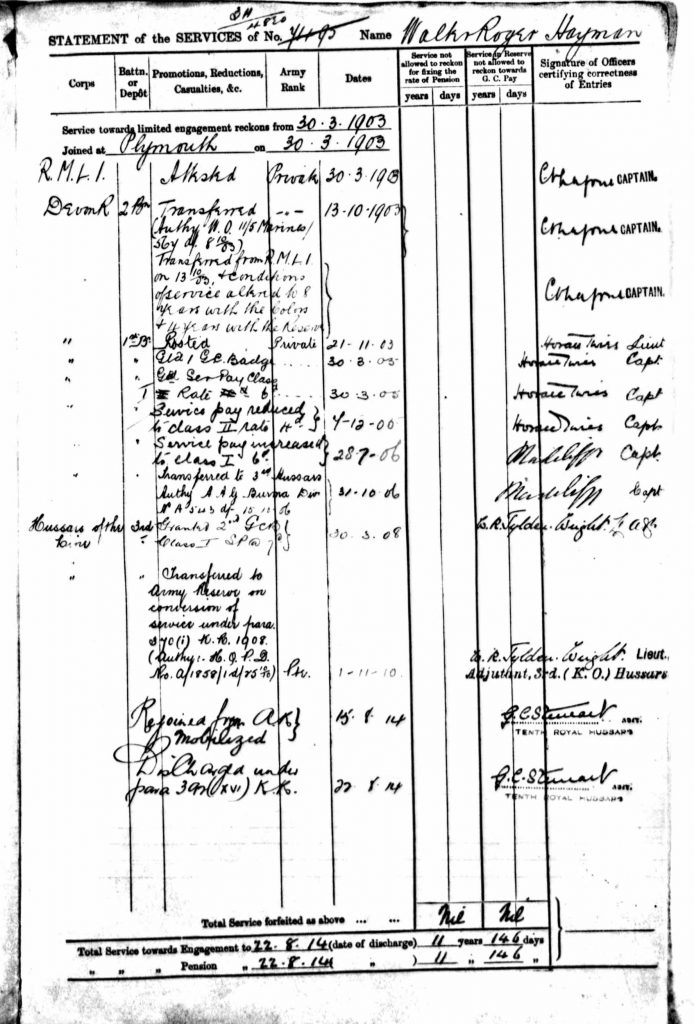
Being on the reserved list, he was immediately called up on August 15th, 1914, at the outset of the First World War, but was discharged under Paragraph 392 of King’s Regulations 1912, just 7 days later as being ‘no longer physically fit for war service.’ With his wife Lilian Marian (nee Hocking) he settled to live at 5 Tower Street, Launceston where he was working a Bar/Cellarman in 1939. He was killed by enemy bombing of the Royal Naval Armament Depot at Bull Point, Plymouth on the 29th of April 1941 aged 58. It could be assumed that at the time he was serving as an auxiliary fireman with the Launceston division of the National Fire Service, who were sent to help aid Plymouth during the blitz, although given his physical fitness in 1914, it is more likely that he could have just been an innocent passenger on a train, as the track near to Bull Point was heavily bombed.
On the 29th/30th April Plymouth and Devonport were again attacked, and, although the raid was on a larger scale than any of its predecessors, it began with inaccurate, bombing in open country North of the city, where wood-fires at Mount Edgcumbe were heavily bombed. It was comparatively late in the raid before the enemy found his targets, and the attack did not therefore seem so heavy as some of its predecessors.
The raid lasted nearly four hours, and, though its effects cannot yet be fully assessed, it is clear that, after all that the city and its environs have lately been through, this raid struck a heavy blow. The main weight of attack was felt at Keyham and Milehouse, between Plymouth and Devonport.
From the Home Security Report for the week.
Arthur John Jago
Arthur, or ‘Bobby’ as he was known, was born in 1924 to Albert and Elsie Irene (nee Callard) Jago at St. Claire, Launceston. His Father was a Postman and Arthur followed into this profession on leaving school. He was a regular attendant of the Launceston Brotherhood and had received two awards for making full attendance for two years. He joined the local Post Office Home Guard before enlisting with the Royal Navy in January 1944 as an Ordinary Seaman (Service No. JX398524). Just five weeks before his death he had come home on leave and many thought he had looked very fit and were very surprised to learn of his death at a Royal Navy Hospital in North Wales on the 22nd of May 1944. He was buried at Abererch (ST. CAWRDAF) churchyard, Wales with full military honours.
Archie Edward Jury
Archie was born in 1911 to Edward and Louisa Jury at Windmill Cottage, Launceston. His father worked as a Mason. In 1934 he married Elsie May Browning in Launceston. He joined the Royal Navy (Service No. D/KX 79574) as a Leading Stoker serving aboard HM Submarine Tempest. He was killed on the 23rd of February 1942. He was mentioned in dispatches and although his body was never recovered his name is commemorated on the Plymouth Naval Memorial. He is also commemorated on the Launceston War Memorial and St Stephens Roll of Honour.
HMS Tempest sailed from Malta on the night of 10 February 1942 to patrol the Gulf of Taranto. On the evening of the 11th Tempest was signalled that the Italians were aware of a submarine in her vicinity and that it should be assumed that her patrol had been compromised. On the 13th, Tempest was sighted on the surface by the Italian destroyer Circe. Tempest crash-dived and Circe began depth charging the area, eventually resulting in oil being seen on the surface. Tempest’s battery tanks had burst filling the boat with chlorine gas and the vessel was forced to surface, whereupon she was hit by gunfire from the Circe. The crew abandoned the submarine, and 23 of the crew of 62 were picked up some 3 hours later by the destroyer. The Italians attempted to board the abandoned vessel but were unable to, due to rough seas. Instead, the Italian destroyer opened fire, scoring more than a dozen direct hits, but failing to sink the Tempest. Finally, the Italians attempted to take the submarine in tow. Two members of the destroyer’s crew boarded the submarine and prepared the tow. As Circe manoeuvred to take up the tow, Tempest suddenly started to sink, forcing those on board to jump into the sea. The submarine slipped beneath the waves stern-first, with the bows disappearing vertical.
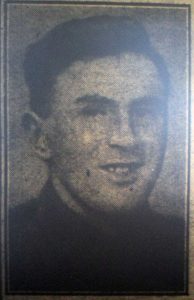
Ronald was born in 1920 at St. Thomas Road, Launceston to Thomas and Emily (nee Cruch) Jury. In 1942 he married Barbara Joyce Evely at Launceston and they lived at Shooting Park, Race Hill, Launceston. He worked a Gardener for Mr. Peter at Trenance, Launceston and was also a member of the Launceston Cottage Garden Society being very successful at the various shows around the district.
He enlisted as a Bombardier with the Royal Artillery (Regimental No. 997470) serving with the 4th Air landing Anti-tank Battery. He was killed in action on the 24th of March 1945. He is buried at the Reichswald Forest War Cemetery, Kleve, Klever Landkreis, Nordrhein-Westfalen, Germany, Plot: 38. F. 4.
Philip Witheridge Manning
Philip was born in 1914 to Philip John and Anne Ethel (nee Witheridge) Manning at Penzance. Philip married Freda May Abbott in 1940 at Launceston. He enlisted with the Royal Armoured Corps (Regimental No. 7912029) 11th, Hussars (Prince Albert’s Own) as a trooper.
He was killed in action at Sollum,12 kilometres from the Libyan border on the 7th of August 1941 and is buried at the Halfaya Sollum War Cemetery, Egypt, Plot: 15. C. 4.
At the time of his death he was listed as residing at No.16 Riversdale Road, West Cross, Mumbles, Swansea. He left a total of £124 3s. 10d. to his wife. His name is also commemorated on the Mumbles war memorial.
John Henry Marks
John was born in 1911 at Launceston to Edward and Hilda Marks. They lived at Trewarlett Cross. He joined the regular army in the early 1930’s serving in India with the Devonshire Regiment as a Lance Corporal (Regimental No. 5616020), before returning to civilian life and marrying Gwendoline F .Dawe at Launceston in 1938. They had two daughters Joy and Shirley and lived at Prockters Place, Launceston. His brother, Bert, was a Corporal in the RAF. As a Reservist he was recalled to the colours before the outbreak of war and was drafted to Malta where he served for three and a half years and came home without a scratch from the terrible blitz that Malta had experienced in the war. He was then sent to Scicily serving with Montgomery’s Eighth Army. On Christmas Eve of 1943 he went home on leave before joining the preparations for D-Day. Just the following day after his wife had received notification of his death, a letter arrived from John telling her that he was quite well and looking forward to coming home on leave. The letter was written on the 23rd of September 1944, just two days before he was killed on the 25th.
Richard Henry Maunder
Richard was born in 1914 to Richard and Jessie (nee Hocking) Maunder of Mount Madford, Launceston. Richard senior was a Rope manufacturer with his father Joseph in what is now Maunder and Sons at Scarne. He enlisted with the RAF serving as a Pilot Officer (Service No. 48170) He was killed in action serving in Egypt on the 21st of May 1942. He is buried at the Heliopolis War Cemetery, Cairo,Al Qahirah, Egypt, Plot: 1. E. 3
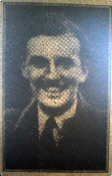
Stanley or Gordon as he was known, was born in 1923 to Stanley George and Lucy McLaren (nee Bickle) at Launceston. He married Marjorie Bickle (who was a Wren) of Chelmsford Street, Silksworth, Durham in 1943 at Tunstall, Durham . Before the war Stanley worked for Pearl Assurance Company.
Gordon joined the RAF as a Flight Sergeant (Service No. 1607034) serving with 140 squadron (Royal Air Force was a Second World War photo-reconnaissance squadron that operated between 1941 and 1945). He is listed as failing to return after an operation on the 14th of September 1944. His body was never recovered but his name is commemorated on the Runnymeade memorial in Surrey, panel 220.
William John Moyse
William was born in 1918 to William and Maud Moyse at Launceston. His Father was a Police Constable. He married and set up home with his wife Mabel, at 2 Western Terrace, Launceston.
He enlisted initially with the Duke of Cornwalls Light Infantry but was transferred to the Royal Engineers (Regimental No. 5438227) serving with the 561 Army Field Company as a Sapper. He was killed in action on the 26th of August 1945. He is buried at the Klagenfurt War Cemetery, Klagenfurt, Carinthia (Kärnten), Austria, plot 1 A 10.
Charles Wilfred Parish (the memorial has his initials displayed as G. W.)
Charles was born on November 7th, 1916 to Eli and Florence Parish at Launceston. He married Laura Mary Davey in 1942 and they set up home at 7 Duke Street, St. Stephens, Launceston. In the 1939 register he is showing as a labourer in recreation. He enlisted with the Durham Light Infantry (Regimental No. 5443235) as a Private. Serving with the 6th Battalion in Belgium he was killed in action on the 10th of September 1944 and is buried at the Geel War cemetery.
In his will he left his effects to the sum of £151 14s. 6d. to his wife. He is also commemorated on the Launceston War Memorial and St Stephens Roll of Honour.
Selwyn Fernley Parsons
Selwyn was born in 1914 to John and Beatrice (nee Butler) Parsons at Launceston. His Father was a Farm Labourer living at Hurdongate, Launceston. He enlisted as a Private with the Royal Army Ordnance Corps (Regimental No. 13063156). He died at sea on the 5th of July 1941. He is commemorated on the Brookwood (1939-1945) Memorial, Brookwood, Woking Borough, Surrey, Plot: Panel 19, Column 2.
Philip Smythe Raddall
Philip was born in 1921 to Thomas Frederick and Mary S (nee Smythe) Raddall at Launceston. His Father was a Commercial Traveller and the family resided at Southgate Arch, Launceston. Philip enlisted with the RAF as a Sergeant (Air Gunner) (Service No. 646713) serving with 218 (Gold Coast) squadron. He was killed in action on the 22nd September 1943 and is buried at the Hanover War Cemetery, Hanover, Lower Saxony, Germany, Plot: Joint grave 12. B. 15-16.
(Niede A series of four major operations against Hanover Over a four week period began on the 22/23rd, at the hands of over seven hundred aircraft. It would prove to be a difficult city to hit, and stronger than forecast winds in the target area pushed the marking and bombing onto the south-eastern outskirts, where little damage was inflicted. Two 218 Squadron Stirlings were among the twenty six missing aircraft, and a third crashed in England after struggling home with severe flak damage. The flight engineer and both gunners had abandoned EJ105 over Germany, but one of the gunners failed to survive the descent, while his colleagues were taken prisoner. F/S Duffy managed to regain the Suffolk coast despite an engine fire, but the Stirling crashed soon afterwards, killing those left on board. EF139 was hit by bombs from above, an ever-present risk for the lower flying Stirlings, and crashed in the target area, killing Sgt Spencer and four of his crew. Finally, BK700 also crashed in Germany, and there were no survivors from the crew of P/O Colquhoun. rsachsen).
Richard Thomas Sandercock
Richard was born on the 20th of August 1908 to Charles and Elsie Sandercock at Launceston. His Father served with the Royal Engineers (Regimental No. 176725) in Salonika during world war one. Richard married Winifred Kate Duance at Launceston in 1933 and they had one Son Tony and one Daughter Jennifer and lived at 5 St. Thomas Road, Launceston.
He enlisted with his Fathers Regiment the Royal Engineers (Regimental No. 5433982) serving as a Lance Sergeant with 7th Bomb Disposal Company. He died on the 30th of April 1941. He is buried at Launceston Cemetery ,Plot B. B. Grave 153.
Fred Sargent
Fred was born in 1902 to Lewis and Ellen (nee Wheeler) Sargent at Launceston. His Father was a Cartman for a Mineral Water Manufacturer. He served his apprenticeship with Mr. Rockey, Butcher of Launceston but left Launceston in 1924. He Married and with his Wife had one Son and one Daughter. He was already in the Army reserve and joined up at outbreak of War in August 1939.
He enlisted at Portsmouth (where he was living) with the Royal Army Ordnance Corps as a Warrant Officer Class I (Regimental No. 7580190) serving in North Africa and Sicily and was also in the Dunkirk evacuation of 1940. He died in a accident in Italy on the 12th of December 1944. He is buried at the Cesena War Cemetery, Cesena, Provincia di Forli, Emilia-Romagna, Italy, Plot: II. G. 7.
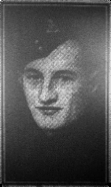
George was born in 1916 at Holsworthy to Francis Charles and Gladys Madeline (nee Horwell) Slade of the square, Holsworthy. His father had served with the Devon Regiment in world was one. He first learnt his trade with Messrs Whitlcok of Holsworthy and went on to work for Messrs Prockter and Kent of Launceston. He was married to Sylvia Bant in 1942 at Lawhitton and had been living with his wife at No 4, Higher Cleaverfield, Launceston. They had one daughter. He enlisted with the The Wiltshire Regiment (Duke of Edinburgh’s) (Regimental No. 5441934) as a Corporal. He was killed in action in Italy on the 9th of May 1944. He is buried at the Beach Head War Cemetery, Anzio, Provincia di Roma, Lazio, Italy, Plot: XIV. G. 4. He is also commemorated on the Launceston War Memorial and St Stephens Roll of Honour.
In May 1944, the Wiltshire Regiment reached Italy and was placed under the command of 78th Division. The Royal Wiltshire Yeomanry was to support 36th Infantry Brigade, with one squadron in support of each of the brigade’s three infantry battalions. In May–June 1944 it took part in the advance on Rome, working its way up in close country between the central mountains and the sea to the west. At one point, 78th Division withdrew but outlying elements of the regiment did not get the message and continued forwards. The Corps HQ diary for 23 June records ‘RWY water truck reports Vaiano clear of enemy’.
(George’s Brother Sapper Charles Slade of the Royal Engineers was a POW of the Japanese).
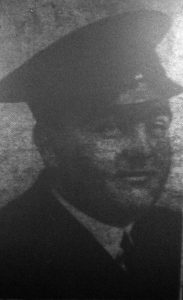
Eric was born in 1919 to John Thomas and Doris Maud (nee Doney) Sullock at Launceston. His Father worked as an Agricultural Labourer. Prior to the war, Eric worked for Mr. Stanley Robbins, Butcher, of St. Stephens Hill. Eric was highly thought of by customers and his employer who held him with high esteem. He was also a highly regarded member of the Launceston Brotherhood.
He joined the Royal Navy on the 13th of June 1940 and became a Leading Steward (Service No. LT/LX 29290) serving with the Royal Navy patrol service aboard ‘HM Trawler Bredon’. He died on the 8th of February 1943. His body was never recovered but his name Is commemorated on the Lowestoft Naval Memorial panel 13 column 2. He is also commemorated on the Launceston War Memorial and St Stephens Roll of Honour. His Majesty’s Trawler Bredon (Pennant Number T223) was a Hill class naval trawler that served as an anti-submarine escort trawler during the Second World War. She was sunk by U-521 on 8 February 1943 while off the Canary Islands. Only 2 souls from her complement of 43 survived. Eric’s body was never recovered.
Cyril Roy Tickle
Cyril was born in September 1920 to Mr. and Mrs. William Tickle (Mother nee Lane) at Launceston. His Father worked as a Printer. Cyril attended Launceston College and on leaving went to work for a Bank in Exeter. He was a Gunner with the Royal Artillery (Regimental No. 1461340) serving with 151 Battalion, 51 Light AA Regiment. He was reported as being taken prisoner at Dunkirk in October 1940. However it was later confirmed that he had been killed in action on the 26th of May 1940. His body was never recovered but his name is commemorated on the Dunkirk Memorial panel 15. He left the sum of £833 6s. 7d to his Father William of 5 Shilson Terrace, Launceston.
Arthur William Thomas
Arthur was born in 1921 to William and Mabel Thomas at 16 Dutson Terrace, Launceston. Arthur joined the Royal Navy as an Able Seaman
(Service No. D/JX 152278) He was serving aboard ‘HMS Furious’ when he died on the 10th of November 1940. He is buried at Bootle Cemetery.
Harold Charles Walters
Harold was born in 1908 to Henry and Lily Walters at Launceston. His Father was a Postman. He was married to Evelyn May Wakem. He enlisted with the Royal Artillery (Regimental No. 1714625) as a Gunner. Harold died on the 21st of January 1944 after a short illness. He is buried at Launceston Cemetery, Plot H. H. Grave 161.
Basil Frederick Percy Bamsey Wingfield
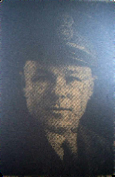
Basil was born 0n September 26th 1905 at Launceston to Frederick Percy and Lily Ivy (nee Sandercock) Wingfield. He was married to Gwendoline Francis Wingfield and had one Daughter Marlene. He was a Chief Electrical Artificer with the Royal Navy (Service No. D/MX 47709) having joined the Navy in April 1929 for 12 years. His first ship that he served aboard was HMS Malaya from August 1930 until October 1931.
Basil died on the 10th of December, 1941 whilst serving aboard ‘HMS Prince of Wales’ which was sunk by Japanese bombers. His body was never recovered but his name is commemorated on the Plymouth Naval Memorial.
On the 25th of October 1941, Prince of Wales departed for Singapore to join Force Z, a British naval detachment. She docked there on the 2nd of December with the rest of the force, and at 2:11 on the10th of December Force Z was dispatched to investigate reports of Japanese landing forces at Kuantan. On arriving there they found the reports to be false. At 11:00 that morning Japanese bombers and torpedo aircraft began their assault on Force Z.
In a second attack at 11:30 one torpedo struck Prince of Wales on the port side, wrecking the outer propeller shaft and causing the ship to take on a heavy list. A third torpedo attack developed against HMS Repulse, a Renown-class battlecruiser in Force Z, but she managed to avoid all torpedoes aimed at her.
A fourth attack by torpedo-carrying Type 1 “Bettys” sank Repulse at 12:33. Six aircraft from this wave attacked Prince of Wales, with three of their torpedoes hitting the ship on the starboard side, causing flooding. Finally a 500 kg bomb hit the catapult deck, penetrated through to the main deck and exploded, tearing a gash in the port side of the hull. At 13:15 the order was given to abandon ship and at 13:20 Prince of Wales sank; Vice-Admiral Tom Phillips and Captain John Leach were among the 327 fatalities as was Basil.
Prince of Wales and Repulse were the first capital ships to be sunk solely by air power on the open sea (albeit by land-based rather than carrier-based aircraft), a harbinger of the diminishing role this class of ships was subsequently to play in naval warfare. The wreck lies upside down in 223 feet (68 m) of water, near Kuantan, in the South China Sea.
This concludes those names on Launceston’s War memorial below are the men from or had a connection to ‘Lanson’ that are not on the memorial.
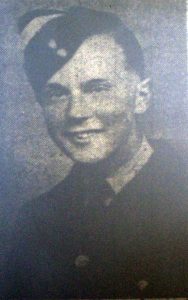
Gerald was born in 1925 to John and Flossie Callow at Langore, St. Stephens. On leaving school he was employed by Messrs. Miller and Son, florists, etc. and later he went to the Admiralty to work. He was a keen sportsman and was well known in singing circles having been a member of the Truscott Methodist Church Choir for some time and was also a valued member of the Sunday School. He had been a prominent member of 1559 Squadron, A.T.C., and the training he received stood him in good stead on joining the R.A.F. as a Air-Gunner (Service No.3032826). He had just been promoted to Sergeant and had been due to come home on promotion leave just a couple of weeks before he was killed in a flying accident between two Wellington bombers (HF517 & MF589) whilst on active service on the night of the 26th of August 1944. He was buried at Truscott Chapel, St. Stephens. Gerald is remembered on a plaque at a garden centre in Prestwood, Buckinghamshire, near where the plane came down (below). He is also commemorated on the St Stephens Roll of Honour.
On the night of Friday 25 August 1944 the two aircraft took off and were airborne one minute apart to practice a night exercise termed a ‘bullseye’. This involved a cross country flight incorporating several different turning points that could be situated anywhere in the UK and was meant to give trainee crews experience that would bind them together into a cohesive unit. Along the route they would probably make a dummy bombing attack on a specified town.
The first Wellington HF517 was piloted by Flying Officer Erik Michielsen (Dutch) and the British crew consisted of Pilot Officer Ronald Junor (navigator), Pilot Officer John Sutherin (Air Bomber), Sergeant James Clarke (Wireless Operator), Sergeants John Butterfiled and Gerald Callow (Air Gunners). The second Wellington MF589 was piloted by Flying Officer Elwood Smith (Canadian) and crewed by four Canadians Flying Officer Vernon Bolton (Navigator), Flying Officer Norman Cousins (Air Bomber), Sergeant James McMurtrie (Air Gunner), Sergeant Raymond Sander (Air Gunner) and one Englishman Sergeant John Poston (Wireless Operator).
At 1.25am on the 26 August these two aircraft collided over Prestwood and fell as burning disintegrating wrecks into the village. Of the twelve crew members, eleven were killed, the survivor Pilot Officer Junor was found wandering in adazed condition in Lodge Wood. In the official report following the collision the conclusion was ‘ failure by both crews to keep an adequate look out’. Report by Ruth Peplow former WAAF.
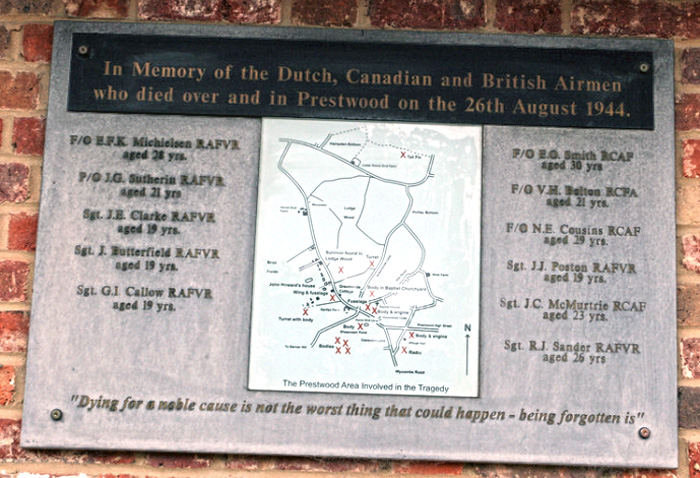

Reginald was born in 1921 to John Henry and Lilly (nee Moon) Lashbrook at 7, Tavistock Road, Launceston. His Father worked for the Railways and had been the Station Master at Ashwater Station in 1911.
He enlisted with the Royal Navy as a Sick Berth Attendant (Service No. D/MX 69442) at ‘HMS Drake’ Devonport. He died on the 15th of March 1941 after falling 120 feet at a quarry near Lifton Park. He is buried at Launceston Cemetery, Plot D. D. Grave 153.
Raymond Ancil Rotherham (although his only connection to the town was through him being at Launceston Hospital where he died)
Raymond was born in 1913 t Albert Arthur and Sarah Jane (nee Ancil) Rotherham at Evesham, Worcestershire. He married Iris Elizabeth Lycett in 1938 at Stratford upon Avon.
He had initially enlisted with the Devonshire Regiment but was subsequently transferred to the Royal Fusiliers (City of London Regiment) (Service No. 5616705) serving with the 15th Battalion as a Corporal. He died on the 8th of August 1941 at Launceston Hospital and is buried in Launceston Cemetery, Plot H. H. Grave 158.
Bob Treleaven
Bob was born in 1922 to James Horswell (who had served in the first world was with the motorised machine gun corps) and Kathleen Elizabeth (nee Colwill) Treleaven at No 7, Dunheved Road, Launceston. The family ran the successful Outfitters Treleaven’s in Southgate Street, Launceston. His Father died in 1939 just after the outbreak of war.
He was a member of the RAF Volunteer Reserve (Service No. 141464) and served as a Aircraftman first class from 1941 in India and Persia. He died at Tehidy Sanatorium after contracting a serious illness in Persia on the 8th of March 1946 and is buried at Launceston Cemetery, Plot I.I. Grave 193.

Jack, as he was known, was born in Camelford in 1918 to Mr and Mrs H. Warren. His mothers maiden name was Rush. The family came to live at Athill farm, Egloskerry by the 1940s. He enlisted with the Royal Corps Signals in 1937 as a Signalman (Regimental No. 2325677). He was killed in action on the 20th of June 1942 at Tobruk, Libya and was buried at Acroma, Knightsbridge, Libya. He is also commemorated on the St Stephens Roll of Honour.
Visits: 343

